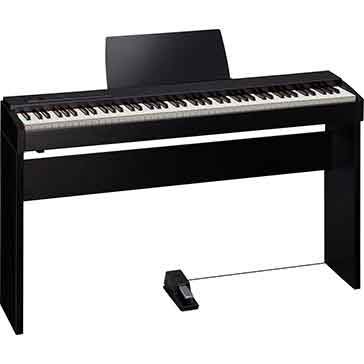The affordable digital piano for home and live use
Buying a digital piano usually involves compromises: pick a more affordable piano, and the sound isn’t up to scratch or key features are absent. Choose a more sophisticated model, and it can be heavy and difficult to transport, as well as being expensive.
The Roland FP-50 is a digital piano that’s playable, portable and affordable. You get the authentic tone and touch of an acoustic grand piano, plus a large selection of versatile sounds for performing in a variety of situations. This entry-level FP piano is designed to be played every day, with a host of features to make your piano practice more rewarding. Sound, touch and style combine to create an affordable piano that rivals high-end instruments costing many times more. So here are four reasons why the FP-50 is equally at home on stage, or, um…at home
1. Style, feel and authentic sound for playing piano at home
The keyboard is the business end of the piano – it’s where you spend all your time, so that keyboard had better be comfortable. The FP-50’s is called the ‘Ivory Feel-G keyboard with Escapement’, which replicates the appearance, texture, and moisture absorbing properties of real ivory. If you’re an experienced player, you’ll appreciate the authentic feel of the keyboard; if you’re a beginner, you’ll be starting in the right place.
Next there’s the sound. The FP-50’s piano sounds are among Roland’s finest, using a technology called SuperNATURAL Piano to power the onboard grand piano sounds. SuperNATURAL is only found on Roland pianos and the FP-50 reacts quickly to your touch over the entire length of the keyboard and the transition of notes from soft to hard is smooth, responsive and realistic – no matter how quickly you play. The ‘decay’ of each note (how long it takes to fade to silence after being played) is also consistent with that of a real grand piano, so the character of the tone changes authentically, as it decays.
2. Easy to carry, hard to beat
The FP-50 is easy to carry, weighing just 15kg. It sounds much bigger than it looks, as in addition to the premium acoustic pianos, it’s brimming with a large selection of inspired stage-ready sounds, including SuperNATURAL-based classic EPs, smoky organ tones, emotive strings, modern synths, and more. Stereo outputs let you connect to an external amplification system, while the built-in speakers help you monitor your performance while on stage. The intelligent rhythm feature gives you control of an entire onboard backing band for solo performing, with automatic accompaniment that follows whatever you play on the keyboard.
3. Helping you become a better piano player
The FP-50 was designed to be played every day and includes several ways to help you practice. You can turn off the built-in speakers and play privately using headphones, allowing you to practice day or night without disturbing family members or neighbours. The on-board Rhythm accompaniments can help you develop your timing and groove, and the wide selection of on-board music styles help expand your versatility. The optional USB memory also lets you play along with your favourite songs saved as WAV audio files, but here’s the clever bit: you can change the key and adjust the speed of the audio, and even reduce the sound of pre-recorded vocals so you can sing over the top. Best of all, you can record your performances back to USB memory as audio data, useful for composing or self-evaluation. SMF songs can be played from USB memory as well.
4. Connect with free Air Performer app – no cables needed either
The FP-50 works with Roland Wireless Connect and the free Air Performer app, and you can play along with your favourite songs in your iPhone, iPad, or iPod touch through the FP-50’s sound system. Roland Wireless Connect is simple to set up and use, providing convenient, cable-free communication with Apple iOS devices via Roland’s optional WNA1100-RL Wireless USB Adapter.
Available in black or white, this compact and stylish digital piano also includes a built-in speaker system, so it’s always ready to go wherever you want to play.
FP-50 in brief
- Roland’s acclaimed SuperNATURAL Piano sound engine
- Ivory Feel-G Keyboard with Escapement
- Built-in speaker system
- Intelligent rhythm feature with full-keyboard chord recognition
- 90 rhythm types, with two variations for each style
- Available in attractive black or white finishes
- Compatible with DP-10 Damper Pedal (included) or RPU-3 Triple Pedal (optional)
- Optional matching stands: KSC-44 (for home use) and KS-18Z (for stage use)
- Optional CB-88RL carrying bag

